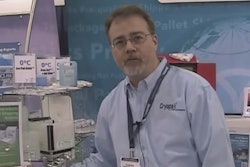Cappers, fillers, tamper band and shrink sleeve applicators, form-fill seal baggers, and a variety of other types of packaging machines show up on the market for purchase as used machines. Buying a used packaging machine offers risks and rewards. The reward is obtaining a perfectly good machine for the application at a fraction of the price of new. The risk is that the machine does not perform to expectations and becomes a drag on the operation. Knowing what to look for in a used packaging machine can significantly lower risk and heighten the reward.
• The first thing to know when buying a used machine is that while models are based on standard platforms, each individual unit may have been, and likely was, custom designed for a particular application and plant environment.
For example, the Axon model EZ-100 tamper band/shrink-sleeve label applicator has a rated speed as posted on the Internet of 150 units per minute. This should be read as up to 150 units per minute. In this example, units-per-minute throughput depends on the size of the container or application. Tamper bands offer the highest throughput because of their small size, while large containers with full shrink sleeve labels will be going through at a slower rate. Anyone seeing a model EZ-100 on an equipment broker’s sale sheet should not assume 150 units per minute. This same caution applies to a capping or bagging machine. One simply does not know whether there is a difference between a used machine and the “base” model being presented by the manufacturing company.
It is difficult to know what application or plant environment the machine was designed for or what unique capabilities it has or does not have simply based on its model number. This means the would-be buyer cannot be certain the machine will meet their needs.
• Customers should feel free to contact the manufacturer and provide a model and serial number. A tech support person can research the facts about the unit’s original design intent and age. These specifications will help answer a few basic questions about whether the original design can be economically converted to meet expectations. This background information does not guarantee success, but is a basic reality check. Buyers purchase a used machine at their own risk.
Identifying the unit through a serial number may also provide background on past maintenance, replacement parts supplied, the age of the machine, and whether the machine was subjected to any extraordinary circumstances. For example, a search on one of Axon’s pre-owned machines found that it had suffered a catastrophic electrical overcharge possibly from a nearby lighting strike.
• Wear can cause package and machine to not quite match up. Such parts as electronics, motors, drive rollers, and a host of other components do wear out. A cursory inspection may show that wear parts seem to be in good shape. It takes a knowledgeable support technician to zero in on a difficult-to-diagnose wear issue. When buying a used machine, wear-parts issues are important to keep in mind. A sensitivity analysis should ideally be performed by the buyer to see what may happen to the business if the machine’s run rates do not measure up, the overall quality of performance is poor, or cost of bringing the machine up to specification is high.
• As a rule of thumb, if the pre-owned machine is 10 years or older, be cautious. The electronics will likely no longer be supported. That’s not to say that if a company bought the machine as new it’s going to self-destruct or need to be replaced when it turns 10. But consider the machine’s total burden of wear parts, the fact that the machine may have been originally custom designed for a particular application and plant environment, and that the brains of the machine are two, three, or more generations old. It simply does not make any economic sense to buy such outdated equipment. After all, who wants maintenance personnel troubleshooting and potentially reprogramming a PLC that’s a decade or more older? Also beware of overpriced older machines. Axon has been contacted by potential buyers who are evaluating older units that are priced at 60 percent of new ones.
• A positive situation would be to find a used machine still in operation at a plant. In that scenario, the buyer could size up the application and environment and compare it to his or her situation. Or, if possible, test drive the unit in sort of a mini factory acceptance test.
As stated earlier, many units are not readily interchangeable and were never intended to be. It is important to find out if indeed the unit was a standard model that was customized and, if customized, what environment it was built for. Some people may not want to contact a manufacturer for information on a used machine because they believe the company representative will try to talk them into a new model. Yes, of course, manufacturers want to sell new machines. Equally true, manufacturers do not want a poor experience with a used machine to poison the well for future sales of new machines. That is a headache for both parties.
Before purchasing a used machine, contact the manufacturer and have the model and serial number available. Talk to the support person and find out whether it was a standard off-the-shelf model or customized. Furthermore, be aware of the pitfalls of buying a used machine such as wear parts and the 10 years and be cautious rule. Use the tips outlined in this white paper to make an informed decision. All of these steps do not guarantee success, but they may provide a few basic and crucial facts about the original intent of the machine under consideration.
###
George Albrecht has more than 35 years experience in the packaging industry. George welcomes your comments, [email protected].
For more information contact:
Axon LLC
3080 Business Park Drive
Suite 103
Raleigh, NC 27610
(T) 1.800.598.8601
(F) 919.772.5575
About Axon
Axon is a leading manufacturer of fully automated, heat-shrink labeling, tamper-evident banding, and stretch-sleeving equipment. With 20 years of experience delivering products and solutions that are affordable, reliable, versatile, and easy to use, Axon sets the standard for technology development and customer value within the industries it serves. Visit Axon at www.AxonCorp.com.
About Pro Mach
Pro Mach, Cincinnati, Ohio, is a leading provider of integrated packaging products and solutions for food, beverage, household goods, pharmaceutical, and other diverse consumer and industrial companies. Through three business units and related divisions, Pro Mach provides equipment, training, installation, and parts in primary packaging, end-of-line packaging, and identification and tracking. www.ProMachInc.com


























